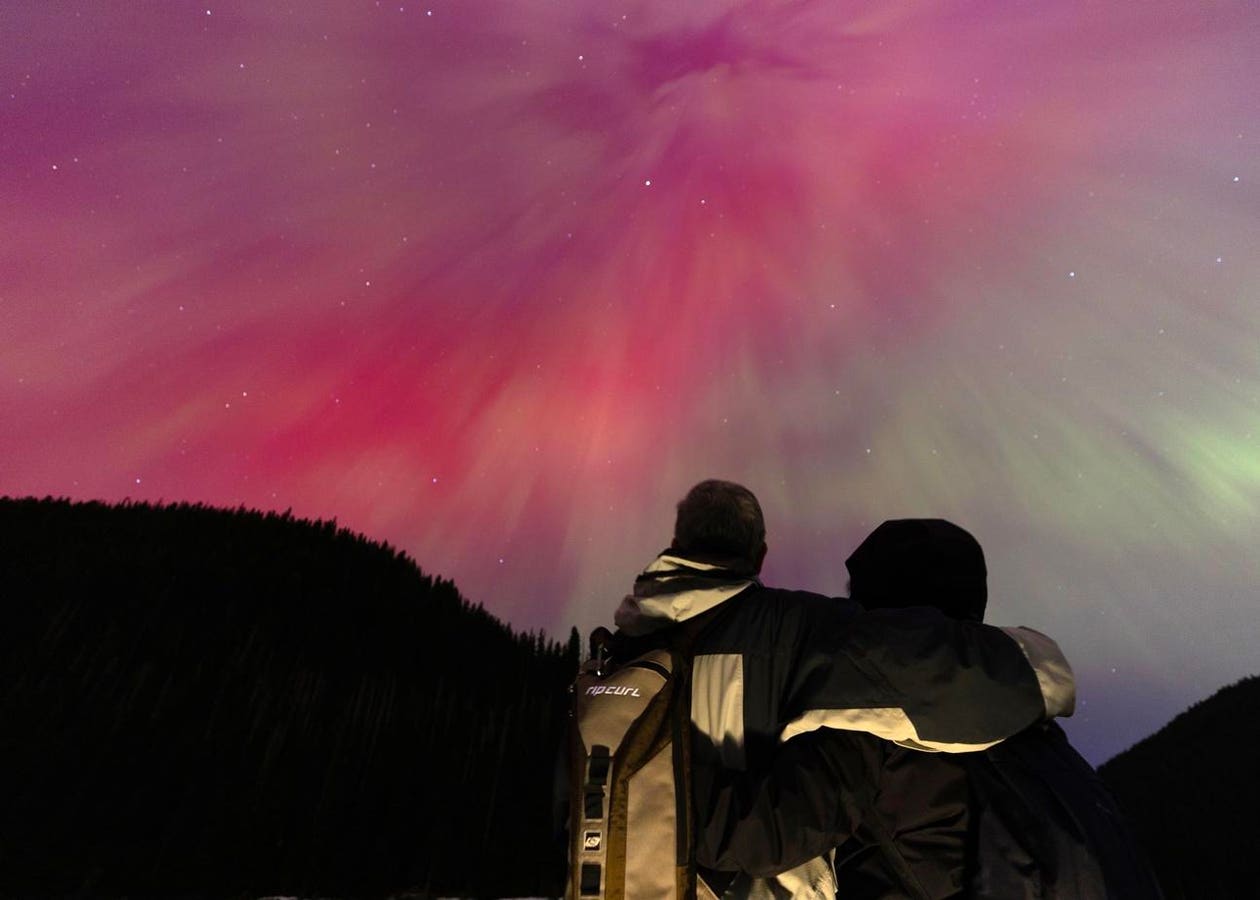A couple watch the aurora borealis, commonly known as the northern lights on May 11, 2024 in Manning Park, British Columbia, Canada. (Photo by Andrew Chin/Getty Images)
Getty Images
The Northern Lights may be visible in the U.S. this weekend after a coronal mass ejection on the sun, according to a forecast by the National Oceanic and Atmospheric Administration’s Space Weather Prediction Center. Although a bright moon — waxing towards being a full moon this Saturday — will make the night sky brighter than is ideal, sky-watchers in 16 U.S. states may have a chance to see the aurora borealis on the northern horizon after dark. That’s also a great time to see “shooting stars” from this year’s Perseid meteor shower, which is building to a peak early next week.
A sunspot erupted on the sun on Tuesday, Aug. 5, which resulted in an M-class solar flare — the first for many weeks — and a coronal mass ejection. This CME, a cloud of super-charged particles from the sun, appears to be traveling towards Earth. It could graze Earth’s atmosphere on Friday, Aug. 8 and Saturday, Aug. 9, reports Spaceweather.com.
Northern Lights Tonight: Forecasts And Alerts
NOAA’s three-day forecast indicates a minor geomagnetic storm, measured at a value of G2 on a scale of G1 to G5. According to NOAA’s forecast, the Kp index — which provides a rough guide to the intensity of aurora displays — may reach 6.
“The geomagnetic field is expected to become active, with a chance for G1 (Minor) storm conditions, late 08 Aug due to the next CH HSS along with shock arrival from the 05 Aug CME event,” reads an update from NOAA. CH HSS refers to coronal hole high speed streams, which means the solar wind can escape more easily from the sun, and will be fast-moving.
NOAA’s latest aurora viewlines indicate that aurora displays are a possibility in northern U.S. states and Canada, with 16 U.S. states having a chance after dark on Friday, Aug. 8 and into the early hours of Saturday, Aug. 9, in parts of North America.
The auroral viewline for Friday, Aug. 8, 2025, according to NOAA.
NOAA
Northern Lights Tonight: Where The Aurora May Be Visible
Parts of U.S. states that could potentially see aurora — if early forecasts prove correct — include Washington, northern Oregon, Idaho, Montana, Nebraska, Wyoming, North Dakota, South Dakota, Minnesota, northern Iowa, Wisconsin, Michigan, New York, Vermont, New Hampshire and Maine. While Alaska is firmly within the aurora oval — and so would normally be expected to see aurora — it currently does not get properly dark at its latitude. Check NOAA’s 30-minute forecast or use the Glendale App for up-to-the-minute forecasts.
Northern Lights Tonight: Full Moon And The Perseid Meteor Shower
Affecting how dark the sky is will be the sturgeon moon, which will turn full on Saturday, Aug. 9. It will rise during dusk — just after sunset — that evening, but also be very bright on on Friday, Aug. 8, and throughout the weekend. It will also affect viewing the annual Perseid meteor shower, which will peak on Aug. 12-13. Although the 50-75 “shooting stars” per hour that are possible during the peak of the Persieds, just a handful of the brightest meteors will likely be visible this year. They can occur anywhere in the night sky.
Northern Lights Tonight: Why Auroral Activity Is High
This uptick is solar activity arrives after a few quiet weeks on the sun. However, the possibility of displays of the aurora borealis at more southerly latitudes than is typical is because of the current solar maximum period — the peak of the 11-years solar cycle during which our star’s magnetic activity waxes and wanes. The sun is now thought to be on the wane, having peaked in late 2024, but the finest aurora displays often occur in the few years after solar maximum — or it there’s a double peak. Aurora sightings in the U.S. could remain possible for a few more years if the current solar cycle has a long tail.
Wishing you clear skies and wide eyes.









